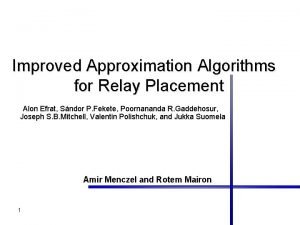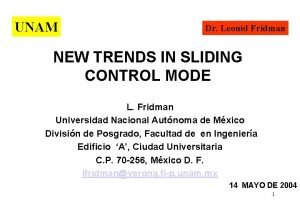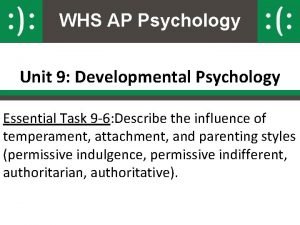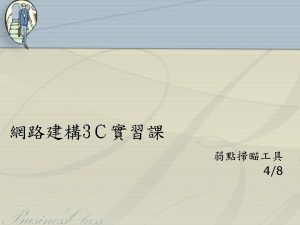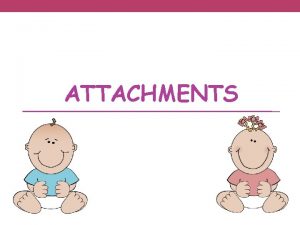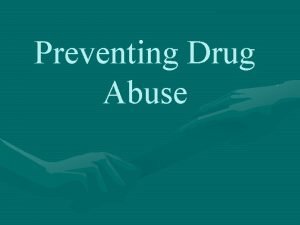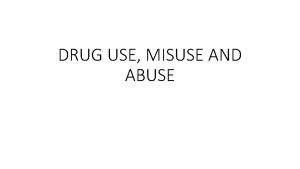Insecure Attachments Female Drug Misuse Efrat S Fridman

















- Slides: 17

Insecure Attachments & Female Drug Misuse Efrat S. Fridman, LCSW

Disclosure I have no actual or potential conflict of interest in relation to this presentation.

Treatment Admissions-Male Vs. Female

In Secure Attachment refers to a deep emotional bond between an individual and their primary attachment figure. In secure attachments develop when child’s needs are not met Traumatic events increase the likelihood that a child develops insecure attachments, even if a secure attachment style prior to the traumatic events existed (Kreis et al. , 2016).

Drug Use –An Attachment Disorder Attachment theory views drug use as a symptom of an underlying problem of insecure attachments , experienced during infancy and early childhood. Drug use - An attempt to self-regulate emotions. Drug use -A desire for contact and connection(Flores, 2004). Drug Use-A protection from symptoms related to trauma.

Drug Use, Women , and Trauma 1. Women who abuse drugs tend to have grown up in families characterized by familial conflict, substance abuse, and domestic violence(Sánchez-Queija et al. , 2015). 2. 90% of women who report using drugs, also report having been abused sexually before the age of 16 years (Sartor et al. , 2013). 3. Majority of women with substance use disorders experience several sexual abuses and rapes, also known as complex trauma (Hein, 2009. )

Drug Use, Women , and Trauma Kries and associates (2016): Similar patterns: Insecure attachment styles that were a result of unmet needs for love, security, safety, and connection. Suffered early traumatic experiences that included abuse, neglect, rejection, abandonment, and parental drug misuse. All began misusing drugs in their teens, as a result of insecure attachments.

Drug Use , Attachment, and Gender Family history of drug addiction are present more for women that use drugs than for men (Brady, Back & Greenfield, 2009). Strong family bonds are associated with lower rates of substance use for both genders , but low parental monitoring are strongly correlated with substance abuse for women.

Drug Use , Attachment, and Gender Men with substance use disorders exhibit antisocial behaviors. The majority of addicted women suffer from comorbid psychiatric disorders, such as PTSD, anxiety and major depression, which are shown to be related to childhood sexual abuse and intimate partner violence (Pape, & Sarabia, 2014).

Women and Connection Women’s need for human connection affects the sense of their identity. Violation of this connection is considered the key to all of women’s psychological problems (Covington, 2007). Drug misuse may develop as an attempt to cope with the pain of disconnection (Kries et al. , 2016).

Implication to Treatment Attachment-based therapy provides an opportunity for contact. The focus of therapy is on creating secure attachments. The group and therapist serve as a safe base, model secure attachments and can reduce the need to manage emotions through using drugs (Fletcher, Nutton, & Brend, 2015)

Disorganized Attachment Style Develops as a result of early trauma, abuse, neglect, or loss. The individual feels like a victim and perceives relationships as dangerous (Wang & Stalker, 2016). The more secure attachment experiences the woman has, the more she will be able to develop a positive approach to self, which can strengthen her responses to stressful situation(Winham, et al. , 2015)

Avoidant attachment Develops as a result of early experiences of rejection. In this attachment style, one denies the need for connection with others and suppresses his feelings. The foundation of attachment-focused therapy is therapistclient dyad. The therapist acts as a safe place and the attachment figure, which was missing from the client’s life in infancy. (Schore & Schore, 2008).

Summary 13 women enrolled in the day center 10 women placed on a waiting list 20 women graduated from the center They all are working, studying and forming connections as parents daughters, partners. one of them, Galia, works as a Counselor in the day program All these women needed was a safe base!

Questions?

Bibliography • Flores, P. J. (2004). Addiction as an attachment disorder. New York, NY: Jason Aronson. • Foy, D. W. , Ritchie, I. K. & Conway, A. H. (2012). Trauma exposure, posttraumatic stress, and comorbidities in female adolescent offenders: findings and implications from recent studies. European Journal of Psychotraumatology , 3, 17247. • Schore, J. , & Schore, A. (2008). Modern Attachment Theory: The Central Role of Affect Regulation in Development and Treatment. Clinical Social Work Journal, 36(1), 9 -20.

Bibliography • Tonnessen, E. (2014). Explaining gender differences in preschoolers’ attachment style • Winham, K. M. , Engstrom, M. , Golder, S. , Renn. T. , Higgins, G. E. & Logan, T. K. (2015) Childhood victimization, attachment, psychological distress, and substance use among women on probation and parole. American journal of orthopsychiatry, 85(2), 145 -58.
 Alon efrat
Alon efrat Leonid fridman
Leonid fridman Betty fridman
Betty fridman Leonid gavrilov
Leonid gavrilov Casa esquina dieguez fridman
Casa esquina dieguez fridman Mohsen kahani
Mohsen kahani Insecure disorganized
Insecure disorganized Bluetooth rfcomm server insecure
Bluetooth rfcomm server insecure Secure vs insecure attachment ap psychology
Secure vs insecure attachment ap psychology Rendered insecure: gpu side channel attacks are practical
Rendered insecure: gpu side channel attacks are practical Insecure connection
Insecure connection Insecure code examples
Insecure code examples Www owasp com
Www owasp com Insecure cryptographic storage challenge 3
Insecure cryptographic storage challenge 3 Owasp top ten most critical web application vulnerabilities
Owasp top ten most critical web application vulnerabilities Insecure.org
Insecure.org Bluetooth rfcomm server insecure
Bluetooth rfcomm server insecure Example of substitution with exhausted drug is
Example of substitution with exhausted drug is
